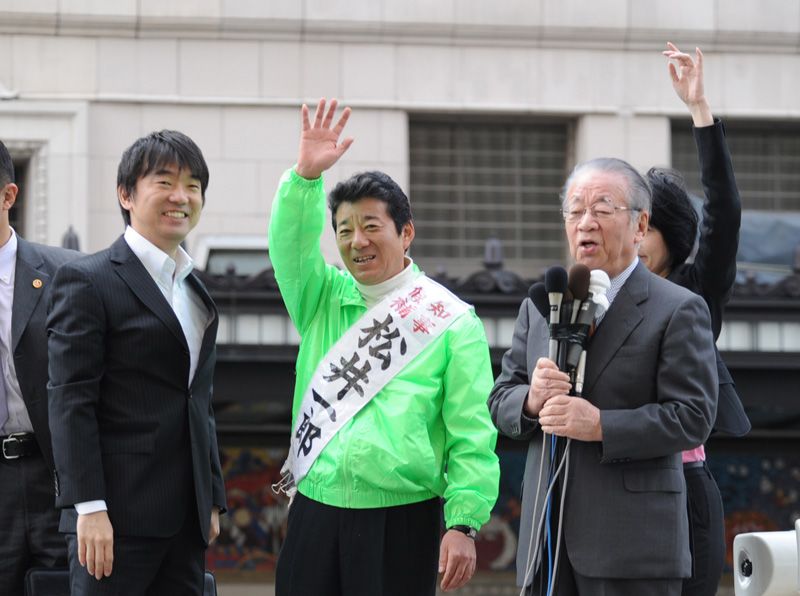Hashimoto Tōru, the Osaka Restoration Association, and the Move to Transform Japan
Politics- English
- 日本語
- 简体字
- 繁體字
- Français
- Español
- العربية
- Русский
The Bureaucratic Grip on Government
 November 10, 2011. Together with Hashimoto Tōru (left), Sakaiya Taichi speaks in support of Matsui Ichirō (center) during his successful campaign for election as governor of Osaka Prefecture. (Photo: Sankei Shimbun)
November 10, 2011. Together with Hashimoto Tōru (left), Sakaiya Taichi speaks in support of Matsui Ichirō (center) during his successful campaign for election as governor of Osaka Prefecture. (Photo: Sankei Shimbun)
The first stirrings of a national transformation are beginning to make themselves felt in Japan today. The changes afoot may eventually have an effect comparable to the Meiji Restoration of the 1860s, when the Tokugawa shogunate collapsed and Japan opened its doors to the modern world.
On November 27, 2011, a “double election” was held to choose the governor of Osaka Prefecture and the mayor of the city of Osaka. The election resulted in a landslide for a pair of reform-minded political allies: Matsui Ichirō as governor of Osaka Prefecture, and Hashimoto Tōru as mayor of the city. Hashimoto’s victory was particularly noteworthy. The leader of the Osaka Restoration Association (a reformist group whose name alludes openly to the nineteenth-century Meiji Restoration) stepped down as Osaka governor to run for the supposedly less prestigious post of city mayor. To explain why he made this move we must take a look at Japan’s peculiar administrative structure and how it has led to what might be called the “tragedy of Osaka.”
Japan’s Odd Political System
The peculiarity of the relationship between the Diet, the cabinet, and the bureaucracy in Japan becomes clear if we compare it to the situation in Britain, where cabinet ministers play a central role and answer questions in Parliament. Although the British cabinet may seek advice from the bureaucracy, the cabinet remains the sole point of contact with Parliament. In contrast, Japan’s bureaucracy engages in behind-the-scenes dealings with Diet members. Bureaucrats make direct appeals to Diet members, urging them to vote in favor of a certain piece of legislation or allocate a budget for a certain program. Diet members become dependent on the information they get from bureaucrats. The cabinet is reduced to the role of facilitator, pulling the political strings on behalf of the bureaucrats and ensuring that the bureaucrats’ agenda gets through.
Japan’s bureaucracy-led style of politics is just as much in evidence at the regional level in the municipal and prefectural governments. There are close links between the national and regional bureaucracies. At the municipal and prefectural level, this relationship is managed through the office of prefectural governor—the only person with a decent chance of grasping the overall situation. Incredibly, of the 47 governors in office today, 34 are former national bureaucrats. This is the reality of Japan’s political apparatus.
In the case of Osaka, there is both an Osaka prefectural government and an Osaka city government. Around the time I was born, back in 1935, the urban infrastructure of the area was limited to the city of Osaka. Beyond the city limits, the region was still quite rural. The city was quite capable of handling all the various urban functions on its own, including the subway and public transport, and the water and sewage systems. The situation changed dramatically following the rapid economic growth that began in the 1950s. By 2010, the total population of the prefecture was 8.8 million, of whom only 2.7 million lived in the city of Osaka. This means that the prefectural government is now required to handle urban functions. As a result, a chronic overlapping of functions has arisen between the prefectural and city governments.
The two governments are often doing the same jobs separately. In some cases they have set up almost identical administrative organs and facilities. The result is extraordinary inefficiency and waste.
To make matters worse, the extreme concentration of power in Tokyo has stripped Osaka of its core economic functions and its ability to convey information. Local authorities languish under the thumb of a central government that exerts ever stricter control over Osaka’s activities and authority. Part of the reason for this is an increase in the size of the public sector as private sector demand has shrunk.
The recent “double election” called into question how Japan’s regions should be governed. Hashimoto achieved impressive results as prefectural governor. Now he says that as mayor he wants to bring an end to the overlapping administrations in Osaka and reform the way the city is governed. His position won overwhelming support from voters.
Will the “Hashimoto Reform” Transform the Bureaucracy?
Hashimoto’s group proposes to cut waste by introducing a “metropolitan government” for Osaka along the lines of the one in Tokyo. Basically, the reform would get rid of the current framework and reorganize the system into a unified government made up of metropolitan Osaka and municipalities with a population of 100,000 or more (10 or so “special administrative districts”). If the plan goes ahead, the municipalities will be responsible for providing basic services to residents, while the metropolitan government will deal with the wider public services and major policy decisions.
This sounds straightforward enough. But making it a reality will be far from easy. First of all, the proposal needs to be approved by the Osaka city and prefectural assemblies and the city assembly of Sakai, which like Osaka is categorized as “designated city” because its population exceeds 500,000. Next would come a referendum, in which the proposal would have to be approved by at a majority of local residents. The Diet would also need to revise the Local Autonomy Law. On top of all that, many vested interests are opposed to the reform–foremost among them (not surprisingly) the bureaucrats and civil servants who stand to lose their positions if their political power is swept away to improve administrative efficiency.
The other pillar of Hashimoto’s reforms is to transform the civil servant system. In Japan, being a civil servant is more like a prestigious social position than a job. Civil servants’ career paths are largely determined by their exam results at the outset of their professional lives. After that, they progress smoothly up the ladder, enjoying steady pay rises regardless of talent or hard work. As a general rule, civil servants also enjoy lifelong job security. Although it seems to beggar belief, there have even been cases in which school teachers absent from their duties for more than five years have still received a monthly salary. Perhaps it is only human kindness to be reluctant to threaten someone’s social standing, but such largesse is something that Japan and Osaka can no longer afford.
The Osaka Restoration Association now holds a clear majority of seats in the Osaka prefectural assembly. This means that the fundamental ordinance on education and the fundamental ordinance on teachers, two pieces of key legislation submitted to the assembly, are sure to be approved. The ordinances make it possible to punish teachers and other school staff with a record of poor performance, including the right to dismiss them. There are also provisions forbidding civil servants from taking cushy post-retirement positions in prefectural public-interest corporations. In this sense, the impact of the ordinances is far from insignificant. They may serve as a chance to crack open the “status system” for civil servants, once thought to be impregnable because of the collusion between bureaucrats and labor unions.
Turning Osaka’s Tragedy into Japan’s Triumph
As I mentioned above, transforming the idea of an Osaka metropolitan government into a reality will require the Diet to pass amendments to local government law. In this sense, the proceedings in the Diet will become a testing ground to gauge where each political party and Diet member stands with regard to a proposed reform that enjoys the overwhelming backing of Osaka voters. It should be clear that the question of whether to create a new metropolitan government has repercussions that go far beyond Osaka.
Back when I was an official at the Ministry of International Trade and Industry (now the Ministry of Economy, Trade, and Industry), I was involved in the preparations for the Osaka Expo in 1970. At the time, the city was a major center of finance, textiles, and home electronics. It was also home to its own style of kabuki and a vibrant literary scene. Many of the most popular creators of manga, now a representative art of Japan, were working in Osaka and often surpassed their Tokyo-based colleagues. Those were the glory days for Osaka.
Osaka continued to generate new industries and businesses up to the 1980s. In fact, it would be hard to list all of the innovative businesses that had their Japanese debut in Osaka, but they include supermarkets, convenience stores, prefab housing, and moving companies. But business innovation in Osaka dried up as the city fell into decline. Power became consolidated in Tokyo and the contradictions arising from the overlapping city and prefectural administrations proliferated.
Today’s effort to revitalize Osaka is not something that will benefit Osaka alone: it is also a struggle to restore the vitality of Japan’s regions, sapped by the centralization of political power. If the metropolitan government idea gets on track, and the pork-barrel practices of civil servants are brought to an end, I am confident that Osaka will once again become a generator of new industries, businesses, and eclectic design, allowing its residents to give free reign to what they call their “enterprising spirit” (or what onlookers might call Osaka’s “frivolous” side).
At the end of the Tokugawa era, just before the 1868 Meiji Restoration, Japanese people were imbued with a political ideology summed up by the slogan: “Revere the emperor, expel the barbarians.” This movement took off because of the propaganda spread by a central government that was reluctant to open up the country. The Tokugawa shogunate handed out full-color nishiki-e woodblock prints depicting foreigners whose faces made them look like goblins or devils. These crude caricatures were not all that different from comments being bandied about today by officials in the Ministry of Agriculture, Forestry, and Fisheries, who go on about the “dangers” of foreign produce in a bid to spur opposition to the Trans-Pacific Strategic Economic Partnership (TPP). The officials know that if Japan opens itself up to more foreign trade, their own vested interests in the agricultural sector will come under threat. In this sense, their outlook is no different from that of the privileged samurai class under the Tokugawa shogunate. I should note, incidentally, that in the Meiji era (1868–1912) the foreigners depicted on the woodblock prints were without exception beautiful men and women—which may give you some idea of the character of the Japanese people.
The Meiji Restoration did not come about because of reform of the Tokugawa shogunate. The starting point was a movement led by Takasugi Shinsaku and his cohorts, as a result of which the Chōshū domain (modern Yamaguchi Prefecture) seized de facto political power. The anti-Tokugawa movement spread like wildfire, and managed to topple the shogunate within just three years. In the twentieth century, transformation of Japan’s political system was similarly swift after World War II.
As I have said, the hurdles we face are considerable. Yet once a movement gets under way, transformations sometimes happen more quickly than anyone expected. The proposed amendment to the Autonomy Law will be submitted during the upcoming ordinary session of the Diet. And after that? We will just have to wait and see . . .
(Based on an interview edited by Minamiyama Takeshi.)
Osaka Hashimoto Toru Matsui Ichirō Osaka Restoration Association Sakaiya Taichi Mamiya Jun metropolitan government concept double administration bureaucrats administrative structure power centralization Tokyo-centered system regional governments reform of civil-servant system.
